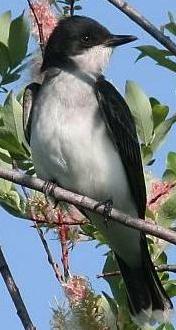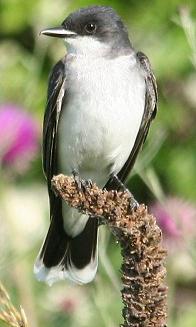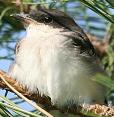 Eastern Kingbird
Identification and Pictures
Eastern Kingbird (Tyrannus tyrannus) 8 to 9
inches Kingbirds got their name because of they are very aggressive in protecting their territory. They will attack any bird that dares get near the nest, swooping down with screaming
cries. Even large birds like hawks and crows will be attacked if they get near the nest. In these
attracts they will even ride on the back of a larger bird and peck at its head.

The attractive Eastern Kingbird is gray-black above and white below, with a white band at the tip of its tail. Its crown has a small patch of red feathers that is not often seen.
The two sexes look much the same. The male crown feathers will more often show a crest. Like other birds in the flycatcher family he sits with an
upright posture. The female does not usually show her crest and tends sit more horizontally on a perch. Photos by Keith Lee using a
Canon
EOS Digital Rebel camera.
 Western
Kingbirds (Regulus satrapa) look
much the same but have yellow below. Western
Kingbirds (Regulus satrapa) look
much the same but have yellow below.
Sound of Eastern Kingbird
Eastern Kingbird's make sharp tzee or tzeet and a rapid kit-kit kitter-kitter calls.
Eastern Kingbird song:
Click for Sound
Preferred Habitat
Eastern Kingbird's like to forage in agricultural areas with shrubs, lightly wooded areas and meadows. They prefer to breed however in wooded areas near rivers, streams or wetlands. They will often
perch on a treetop, cattail or fence post where they can get a clear view of the surrounding area.
Breeding and Nesting
As in many birds the males do elaborate displays in the air. The female builds a large nest of weeds, twigs and bark lined with feathers and plant down. The nest can be in a shrub, low tree near water or even on a man made structure. The
female lays 2 to 5 creamy white or pale pink eggs, with dark blotches. She incubates the eggs for 14 to 17 days.
dark blotches. She incubates the eggs for 14 to 17 days. Brown-headed Cowbirds will often lay their eggs in the nests of Kingbirds. Kingbirds will often
destroy these eggs if before their own are laid but are more likely to leave them after theirs are laid. The young birds will be fed by both parents until start to fly in around 17 days, and will
continue to feed them for up to five weeks after this. The young tend to
remain with the parents until the birds gathers in flocks for migration. around 17 days, and will
continue to feed them for up to five weeks after this. The young tend to
remain with the parents until the birds gathers in flocks for migration.
MigrationEastern
Kingbird's will gather in large flocks much like waxwings during migration and winter mostly in South America.
Food and Feeding
Kingbirds feed on insects in spring and summer, and like fruit and berries when it becomes available. They will sit on a perch and fly out to grab insects out of the air. They also feed on the ground, especially in winter.
For more on food
and feeding click here.
For more on feeders click here.
To learn about other favorite
birds click here.

|
